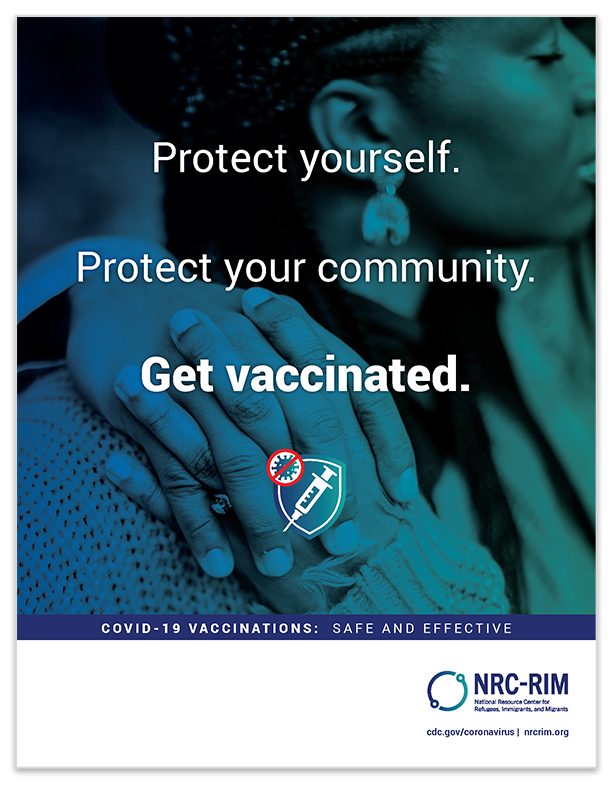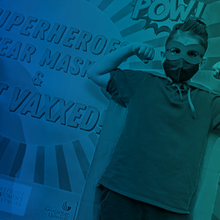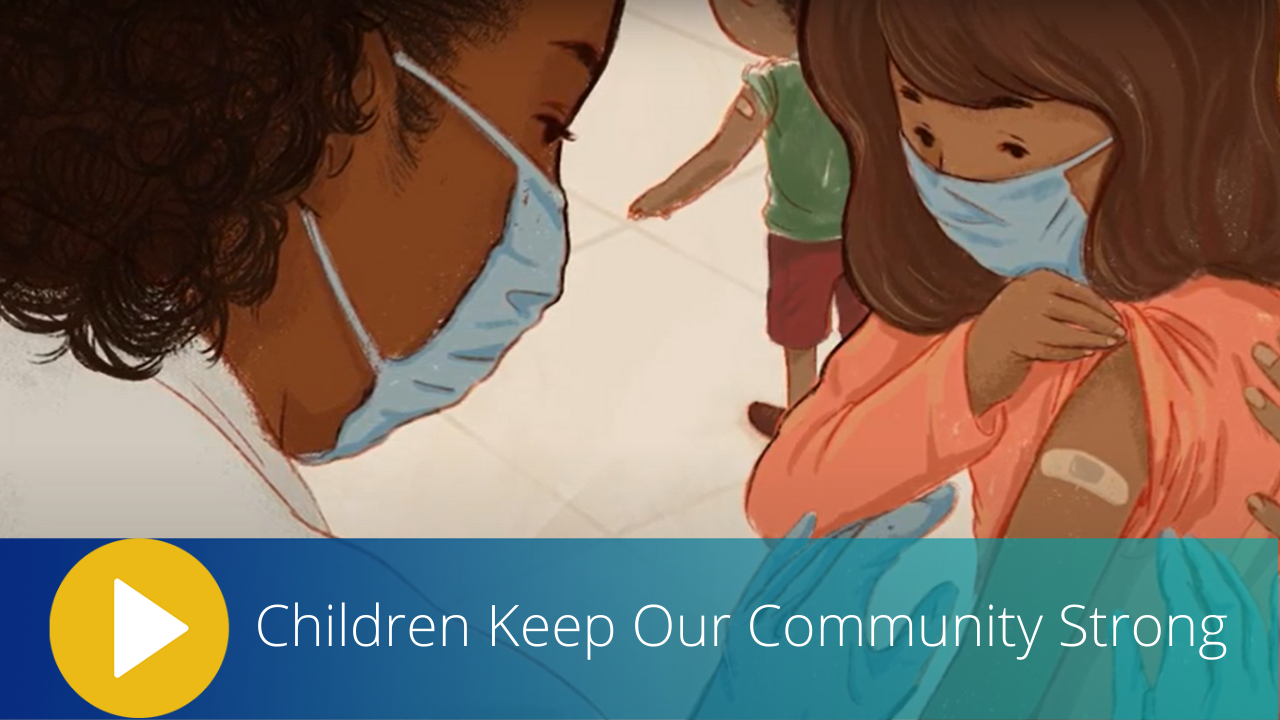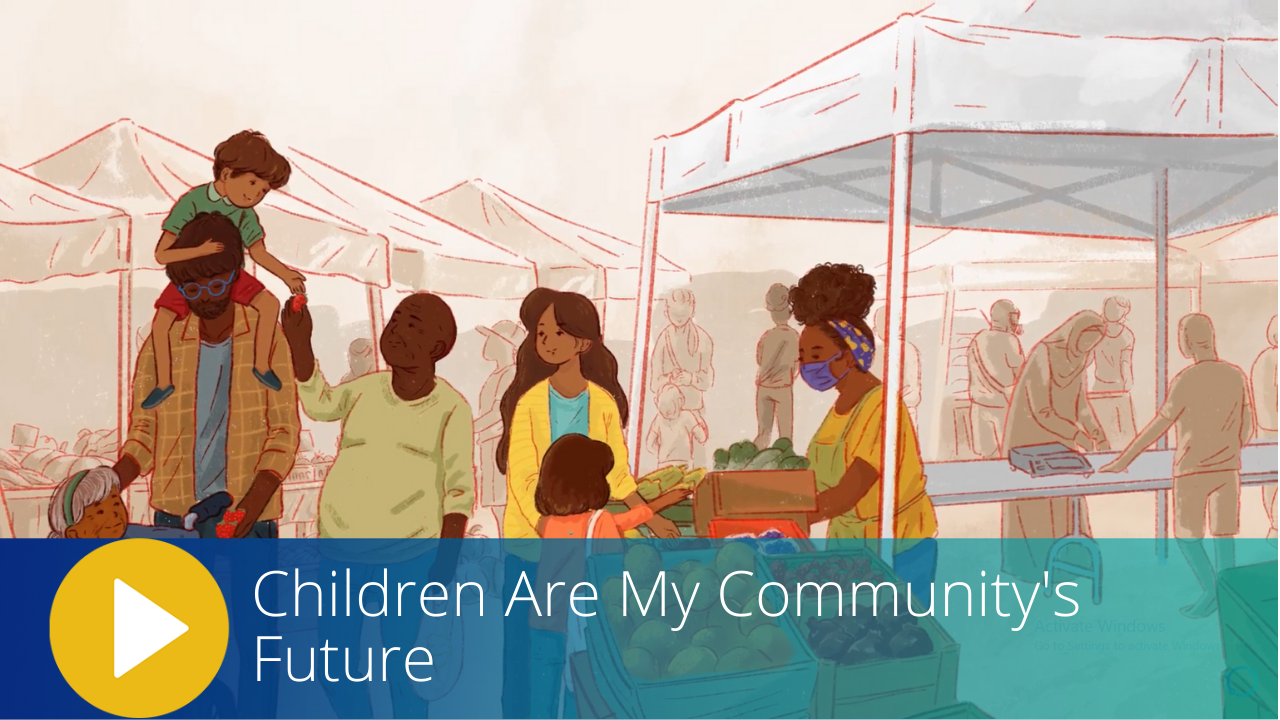
An effective COVID-19 response must involve
schools
As schools across the country are going back in session this fall for in-person learning, consider partnering with your local school district to promote COVID-19 vaccines, testing and contact tracing among teachers, staff, families, and eligible students. NRC-RIM has resources, fact sheets, and best practices to support your efforts.
School Health Messaging PSAs
The International Rescue Committee developed these helpful resources outlining tips that can be sent to caregivers via SMS, TextIt, email or posted on social media. Pick and choose which messages to send or create a multiday campaign.
Arabic | Dari | Nepali | Pashto | Spanish | Swahili (Congolese)
Be a Superhero: How to Increase COVID-19 Vaccine Uptake in Schools through Community Collaboration (webinar)
Learn how the International Rescue Committee, the Dekalb County Department of Health, and Principal BB from Indian Creek Elementary worked together to create a series of COVID-19 vaccine events in the spring of 2022 with superhero-themed events. Learn more
Fact Sheet: Vaccines for Children and Youth
All of our fact sheets are based on CDC guidance, offering facts about COVID-19 vaccines in a simple and memorable way that counters common misconceptions. Our fact sheet on vaccines for children and youth addresses safety, side effects, and what to expect before, during and after the appointment. We also have a conversation guide on the same topics.
Our fact sheets include translations in more than 40 languages as well as the ability for you to customize the logo, URL, photo and more. Translations for this fact sheet are coming soon.
Video: Children Keep Our Community Strong
In this animated short, one immigrant mother explains why she chose to vaccinate her two children against COVID-19. "I am proud of the life we have built in the United States, and I want my community to thrive for years to come," she says. "The COVID-19 vaccine helps us play together, worship together, learn together, and keep our community strong."
English | Arabic | Burmese | Dari | French | Karen | Kinyarwanda | Lingala
Nepali | Pashto | Russian | Spanish | Swahili | Tigrinya | Ukrainian
Video: Children Are My Community's Future
In this video, one immigrant father explains why he chose to vaccinate his two children against COVID-19. "Our two children need our protection," he says. "We are doing everything we can to make sure they can grow up and have their own families someday."
English | Arabic | Burmese | Dari | French | Karen | Kinyarwanda | Lingala
Nepali | Pashto | Russian | Spanish | Swahili | Tigrinya | Ukrainian
- Vaccine clinics at schools
- Translating materials
- Communication tools
- COVID-19 Testing
- Contact Tracing
- Other Resources
How Schools Can Support COVID-19 Vaccination
On this page, the CDC provides action steps school leaders can take to support COVID-19 vaccine uptake and improve health literacy among staff, students, and families in their community. Learn more
Considerations for Planning School-Located Vaccination Clinics
This guide from CDC includes resources for planning and implementing school-located vaccination. Modifiable template communication materials are also provided. Learn more
Guide to On-Site Vaccination Clinics for School
U.S. Department of Health and Human Services offers a simple step-by-step guide for hosting vaccine clinics at schools. Learn more
Checklist: COVID-19 Vaccine Roll-out among Refugees, Immigrants, and Migrants
Ensuring opportunities for COVID-19 vaccination among refugee, immigrant, and migrant communities is important. Consider the following actions when implementing vaccination campaigns among these communities. Download now
Guide: Mobile COVID-19 Vaccination Campaigns for Refugee, Immigrant and Migrant (RIM) Communities
Bringing healthcare, including COVID-19 vaccinations to where people live, work, learn and play has promising potential to improve community engagement and communities. This guide is intended for health professionals, public health departments, and community organizations to help plan vaccination events for RIM communities. Download now
Recommendations for Welcoming and Inclusive Vaccination Sites
The following recommendations are to build upon our shared goal of equitable and accessible community vaccination opportunities. These recommendations are being shared with all vaccine providers as a way to assure a positive vaccination experience for all communities. Visit now
Guide: Creating Effective Translations
Successful translation of content represents an accurate and clear written document in another language that maintains and communicates the initial intent in a culturally appropriate manner. This is a challenging goal and involves more than asking someone, or using automated translation software to translate word for word. Download now
Content Validation Guidance and Checklist
Content validation is a structured process through which bilingual, bicultural community members review materials and provide critical feedback to ensure the material is appropriately designed and/or translated for the community it is trying to reach. This guide offers practical suggestions - including a checklist - for implementing a content validation process for your materials. Download now
Toolkit for Written Translation
A good translation involves more than just putting the text into another language. This toolkit provides resources and best practices for to consider when having materials translated into other languages. Download now
Conversation Guides
Many client-facing staff are receiving client questions related to the COVID-19 vaccine. Developed by NRC-RIM, these resources help client-facing staff competently respond to common vaccine questions. Visit now
Guide: Working with Social Media
Given that social media is now embedded in our daily activities, public health practitioners can use these platforms to provide actionable information to distribute health information to communities. This guide gives an overview of strategies you can use with Facebook, Twitter, Instagram, and WhatsApp, as well as Google advertising. Download now
Guide: Working with Traditional Media
Traditional media platforms like radio, newspapers and television are important methods of communication for many people in our communities. Using these platforms with coordinated messages ensures the whole community hears a consistent message. Download now
Guide: Addressing Legal Concerns Around Immigration-Related Vaccine Hesitancy
Immigrants may have concerns about government authorities’ access to personal information provided at vaccine clinics. For some immigrants, even the notion of confidentiality in government processes is novel. Learn how to build partnerships ahead of vaccination clinics and how to design an affirming vaccination event. Download now
IDs and Insurance: Know Your Rights
This resource, created by Made to Save, answers commonly asked questions about COVID-19 vaccine eligibility and immigration status, health insurance status, and being asked for a valid ID. Download in English or Spanish
Guide: COVID-19 Testing in Schools
Learn about the benefits of testing programs in schools and what to do if a student or staff tests positive. View Now
Checklist: COVID-19 Testing among Refugees, Immigrants, and Migrants
This is a checklist of actions for health departments to consider when offering COVID-19 testing services to refugee, immigrant, and migrant (RIM) communities. Download Now
Guide: Mobile COVID-19 Testing among Refugee, Immigrant, and Migrant (RIM) Communities
This comprehensive resource offers practical guidance to testing event organizers interested in mobile testing among refugee, immigrant and migrant communities. The guide covers step-by-step instructions on identifying community partners, planning the event, implementing the event, and follow-up. Download Now
NRC-RIM Testing Toolkit
Effective communication and planning is essential to ensure your testing program reaches refugee, immigrant and migrant communities in your area. Learn more
Contact Tracing Campaigns
We worked with IDEO.org, a nonprofit design studio, to build contact tracing campaigns in partnership with a community of farmworkers in Florida, and a community of Congolese refugees and migrants in Texas. Our goal was to co-create messaging that built awareness and creates willingness to participate in contact tracing. Learn more
Checklist: CICT among Refugees, Immigrants, and Migrants
This is a checklist of actions for health departments to consider when conducting CICT among refugee, immigrant, and migrant (RIM) communities. Download now
Tips for Working with Interpreters during CICT
Partnering with a professional interpreter is an important strategy when conducting case investigation and contact tracing (CICT) with community members who do not speak the same language as the CICT professional. This document is for CICT professionals and outlines practical tips for working with interpreters. Download now
NRC-RIM Contact Tracing Toolkit
By embracing community engagement and partnerships, and taking into account cultural and linguistic considerations, you can ensure your contact tracing efforts are successful. Learn more
Welcoming Refugee Students – Guides for Classroom Teachers, School Nurses, School Administrators, School Counselors, Peer Mentors, and Parents
These guides are part of the New York State Welcome to Our Schools (WtOS) program, designed to ease the transition of refugee children into elementary and secondary schools and to empower their parents to be effective partners in the education of their children. Learn more
Partnering with Parents and Families to Support Immigrant and Refugee Children at School
This guide by the Robert Wood Johnson Foundation outlines programs that engage communities and community organizations to build effective and easily accessible mental health services for children and youth. Key issues include: partnering with immigrant families to support mental health; offering school-based mental health services; and the changing face of American classrooms. Learn more
Toxic Stress and Well-being among Students Affected by Forced Migration
This course, developed in partnership with the New Jersey Department of Education, and the International Rescue Committee, covers common experiences associated with forced migration and key ways stressors can be mitigated in classrooms, schools, and out-of-school time program environments. Learn more
Supporting Refugee Students with Interrupted or Limited Formal Education (SLIFE)
This course from the Center for Learning in Practice is designed for classroom teachers working with SLIFE and/or refugee youth, mentors, coaches, administrators, or teacher preparation program professors working with teachers of refugees. Learn more
Convenient Vaccine Access for Communities
Bringing vaccines to communities, rather than relying on community members to find their way to medical services, is more efficient and has much greater efficacy. Select this promising practice to learn more.
Encouraging Youth to Mask Up and Get Vaccinated for their Families and Community
One successful strategy to slow the spread of COVID-19 in RIM communities is to appeal to young people. This can be done by highlighting their community’s cultural values, which may include solidarity, collective responsibility, reciprocity, duty to family, respect for elders, or other values that are consistent with taking action to protect others.
Encouraging COVID-19 Vaccination through Sports
Building trust in the vaccine through community partnerships and respected officials are key to improving vaccination rates. Engaging communities at familiar and frequented event sites, such as sporting and routine athletic events may be one strategy to decrease some of the barriers to vaccination access for RIM communities.
Youth and Young Adult Ambassadors
Youth and young adults continue to have low COVID-19 vaccination rates across the US. Engaging youth is vital in the next stage of vaccine promotion and for reaching herd immunity. Learn how youth ambassadors bring their unique perspectives on how to cut through the noise to deliver important COVID-19 messaging to young people.
Staffing Agencies to Increase Language Capacity
Health departments are partnering with staffing agencies to hire multilingual case investigators / contact tracers and contract interpreters. Select this promising practice to learn how to utilize staffing agencies to increase the language capacity of your team.
Phone Trees to Facilitate Vaccine Access
To respond effectively to COVID-19 and to longstanding health inequities made worse by the pandemic, it is essential to leverage community strengths and trusted community networks. Phone trees are one strategy to disseminate important public health information during the pandemic.
Vaccine Ambassadors Program
The Vaccine Ambassador program is led by a state health department and supports community members to serve as trusted messengers of COVID-19 vaccine information.
Initiating the COVID-19 Vaccine Conversation through Flyers
Dispelling myths and alleviating apprehensions around vaccination requires a trusted relationship and a safe, non-judgmental environment for individuals to voice their concerns and ask questions. Initiating COVID-19 vaccine conversations through flyers is a creative way to use a traditional communication method.
Role of Public Libraries in COVID-19 Vaccine Rollout
Public libraries serve as ideal partners for COVID-19 vaccination rollout. As a trusted source of information and a well-connected hub within their local communities, libraries across America are working with local and state governments and community leaders to support vaccination efforts.
Mobile Vaccine Units to Serve Communities
Ensuring equitable barrier-free access to vaccines and accurate health information is especially critical for RIM communities to mitigate the disproportionate impacts of COVID-19. Mobile vaccine units are proving to be a successful solution for ensuring COVID-19 vaccines reach RIM populations.
Culturally Specific Vaccine Information Broadcasts
By partnering with media outlets that are trusted in the community, vaccine messages can be culturally tailored and address unique concerns.
WhatsApp to Reach and Engage RIM Communities
WhatsApp is a popular social messaging tool for many communities, including refugees, immigrants, and migrants and can be a powerful tool to reach and engage communities.
Facebook Videos to Engage Communities
The use of Facebook to share informational videos about COVID-19 among RIM communities and/or to deliver live content through the Facebook Live feature are promising practices for reaching RIM communities.
Vaccine Listening Sessions with Communities
A listening session is a facilitated discussion with a group of individuals aimed at collecting information about a specific topic. Listening sessions are an effective way to hear directly from communities about COVID-19-related topics, including vaccines. Select this promising practice to learn more about vaccine listening sessions.
Multilingual COVID-19 Vaccine Education Workshops
COVID-19 vaccine education workshops, facilitated in a language the community member understands, increases trust, and helps RIM community members make informed decisions about COVID-19 vaccine for themselves and their communities.
Partnerships with Youth Groups
Partnerships with existing community groups are essential for reaching underserved communities and improving the delivery of COVID-19 related services, resources, and information. Youth groups can be especially effective outreach partners.
Partnerships with K-12 Schools Serving RIM Communities
K-12 schools serve as community resources to assist students and families from refugee, immigrant, and migrant communities and are uniquely positioned to bridge cultural and linguistic knowledge gaps for health departments.






